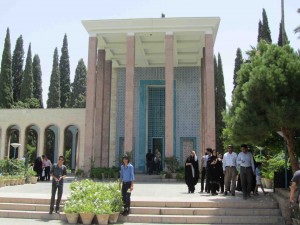Deborah James advocated for Fair Trade at Global Exchange from 1993 – 2005, and now serves as a member of the Global Exchange Board. She is currently the Director of International Programs at the Center for Economic and Policy Research. She recently participated in the Citizen Diplomacy Delegation to Iran with Reality Tours. In a series of posts, she shares with us her experience.
July 4, 2010 Shiraz
Today we are leaving the beautiful city of Shiraz, known for its gardens, nightingales, roses, wine, and poets. When we arrived, the first person we saw was dressed in tight jeans, a figure-hugging manteau and Sex-in-the-City high heels! Shiraz is also known in Iran for being a very liberal city. And while unfortunately, the wine is no longer to be found, poetry abounds here.
Most Americans do not associate Iran with poetry, but it is essential to the country’s identity. From a thousand years ago, when Ferdowsi penned the Persian epic history, the Shahnameh, in verse; to the Rubaiyat poetry of mathematician Omar Khayyam, written around 1100 AD; the Masnavi of the Sufi mystic poet Rumi, and the Golestan and Bustan of Sa’di, both written in the 1200s; to the unparalleled Hafez, whose collection of poems from the 1300s speak of courtship and wine, the country has an illustrious history of world-renowned, mesmerizing poetry. In fact, the gorgeous mausoleums of Sa’di and Hafez, both of whom resided in Shiraz, are considered pilgrimages by Iranian school groups and tourists alike, as evidenced by the throngs of Iranians present and reciting verse when we visited!
Shiraz is also renowned for its lush Persian gardens, which we took great advantage of to escape the day’s heat. A refreshing mix of cypress, palms, sycamore, and other shading fruit and nut trees, mixed with flowering plants of honeysuckle, jasmine, and bougainvillea. Some of the gardens are run as public spaces where families picnic; others were the private gardens of the fabulously wealthy, complete with lavishly decorated mini palaces, now endowed to the Ministry of Culture for public view. It was easy to see how the famed Persian gardens inspired both the poetry of the region, as well as the exquisitely detailed miniature paintings we saw in the bazaar of Shiraz.
We also visited a teahouse. Our small group, a born-Catholic, a Jew, and a Muslim enter the Seray-e Teahouse in the Serai Mushir craft area of the Vakil Bazaar, a former caravanserai (a hotel for traveler caravans on the Silk Road). We ascend curving staircase, peek through beaded curtains, and see wooden picnic-style benches covered in Persian woven tribal kilim rugs. My eyes immediately fix on the polychrome tile representations of polo players, lovers and music, poetry and wine from the Shahnameh by Ferdowsi that cover the walls. Colored light passes above through the metal cut-out lanterns. We sit down at tables, covered in Shirazi woven red and gold paisley tablecloths. A waiter brings a porcelain tea set with small glasses bearing the image of the 4th Qajar king. Nasser ol-D in Shah ruled from 1848 to 1896, and is known both as a great patron of the arts, as well as the shah who gave so much of the country away to Russian and English concessions. We dip hand-cut sugar cubes into the tea, which we then sip through the sugar held behind the teeth. After a moment, the prize arrives: a qaylan, traditional water pipe, through which we inhale delicious mint-scented tobacco and blow thick curls of smoke. It is another perfect moment in Iran.
We meet some young people in an Internet café. They are studying to be architects and engineers. Unfortunately, they don’t see future job prospects in Iran, and are planning on leaving to find a place where their skills can be put to good use. The recession has cut off many of those opportunities internationally, however. I ponder how much worse this situation will get due to the sanctions…
After a few amazing days of visiting gorgeously tiled palaces, green gardens, and perusing the bazaar, it is time to leave. I read Hafez and Sa’di in the car, while looking out at the lovely Zagros Mountains, seeing all the walnut, almond, pistachio, fig, plum, and apricot trees; grapes, eggplant, tomato, spinach, potato, wheat, barley, and rice farmland; along with the sheep and goat pastures.
Because of this rich bounty, Persian food has far exceeded my expectations! For breakfast we enjoy delicious fresh yoghurt every day, wonderful omelets with tomatoes and mushrooms, or eggs with tomato and cucumber and a feta-like cheese, and coffee. At lunch and dinner we eat like queens – first salad and yoghurt with flatbread, then a wonderful barley soup, and a mouth-watering roasted eggplant dish unlike any I’ve ever tasted. Then there’s grilled fish or lamb or chicken kebab, served with a bowl of fresh mint, basil, and other herbs, or national dishes like fesenjun (a rich sauce of ground walnuts and pomegranates). All very healthy and delicious!
Not many oil-rich countries maintain a focus on self-sufficiency in agriculture as Iran has, but farming here is far more ancient than oil. We hear from Iranians that because of the sanctions, many of the government subsidies that keep prices low are going to be reduced, and they are concerned about the impact this will have on food prices, particularly for the less well off…
Read the rest of Deborah James’ ‘Journey to Iran‘ blog posts.

